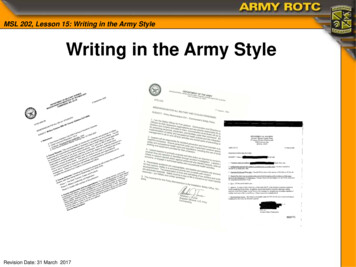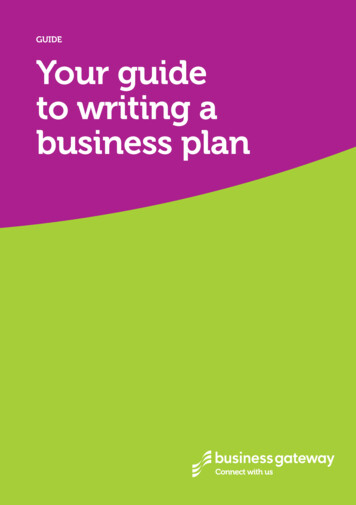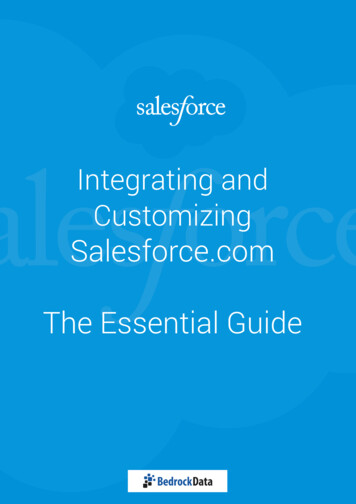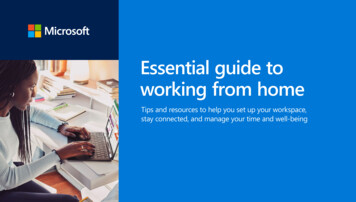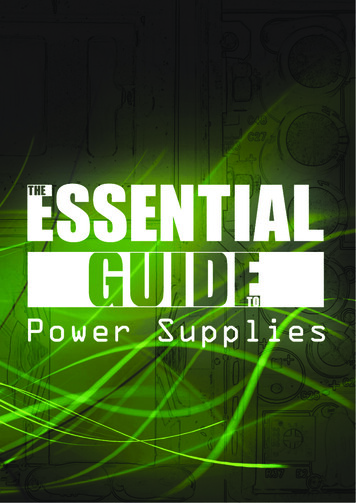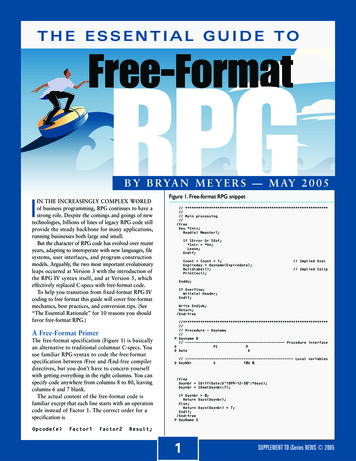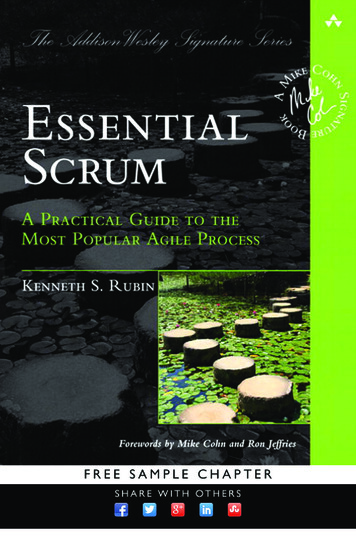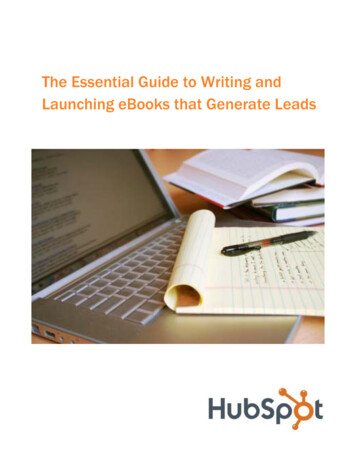
Transcription
The Essential Guide to Writing andLaunching eBooks that Generate Leads
2 The Essential Guide to Writing and Launching eBooks That Generate LeadsTable of ContentsOnce Upon a Time3Setting Goals4What’s It All About?5The Road Map7Start Writing8What Not to Write9Dealing with Writer’s Block10Design and Layout11One for You, Two for Me12A Rose by Any Other Name13Editing and Proofreading14Landing Pages15Market Like a Mad Man16Post-Mortem17It’s Not Recycling, It’s Repurposing18The End197 Insider Tricks of the Trade20Tweet This eBook!
3 The Essential Guide to Writing and Launching eBooks That Generate LeadsOnce Upon a TimeMost storytellers will tell you the best place tostart is at the beginning. Most storytellerswould be wrong.True, that’s where you’ll want your readers tobegin, but for something as important andresource-intensive as an ebook, as the authorand publisher, you’d better start at the end.More specifically, what do you want yourebook to accomplish? Once you’veestablished your goals – what the end gameis—you can circle back around to thebeginning and map your way from openingsentence to final call to action.Tweet This eBook!
4 The Essential Guide to Writing and Launching eBooks That Generate LeadsSetting GoalsYou’ve established the fact that you want yourebook to generate leads, but what kind of leads,exactly? Who is the target audience for this book?Are they already your customers and you want toentice them to come back and spend a bit morewith you? Are they prospects you’re hoping willdownload the book and then be prompted to giveyou a try with an order or call for an estimate orproposal?What’s in it for the reader? Are you going to educate them about your products and servicesspecifically? Are you going to give them sound advice they can use in their own businessesto operate more effectively or efficiently, more profitably? Are you trying to position yourcompany as experts in the field, filled with knowledge and experience that sets you apartand above your competition?What problems is your ebook going to help them solve?You’ve got a lot of questions to answer before you sit down at the keyboard to write a singleword. Essentially, what do you want this book to accomplish for you and what will it providereaders?Why should readers care enough about your ebook to hand over their precious informationand then give something even more valuable—their time—to read what you have to say?Tweet This eBook!
5 The Essential Guide to Writing and Launching eBooks That Generate LeadsWhat’s It All About?You already know the world, the Web, isbrimming with content. So, before you investhours, days, weeks even, penning yourebook, you’d be wise to see what ispublished on the topic you have in mind.How will your ebook be different? What isyour ebook going to offer that’s new,different, better than anything out therealready? Understand the competitivelandscape so you can produce an ebookthat fills a void in the marketplace.To write a successful ebook, one that will get read from start to finish, you need a clear,overarching topic, one that’s compelling enough to get people to complete your conversionform—which is much harder than it seems.You’ll know you have a clear topic when you can explain it succinctly—ideally in onesentence.The topic for this ebook, for example, is, as you already know, “how to write an ebook thatgenerates leads.” Whether it’s “How to Play the Piano,” “How to Tweet Like a HollywoodSuperstar” or “How to Facebook Your Way to Fame and Fortune,” the topic is why you’rewriting the book and why you hope people will read it.If you can’t encapsulate your book’s topic in one or two sentences, you most likely don’thave a solid foundation on which you’re going to build your entire story; you just have aseries of loosely connected ideas which may interest some readers or no readers becausethe purpose of the book is itself vague.Okay, so your topic has to be razor-sharp. But, how do you decide which topic to write about?That’s easy. And hard.The easy part is: What do your customers and prospects want to know that you areespecially qualified to write about authoritatively? In your business, do people oftenapproach you with the same question or set of questions they’re looking to you to provideanswers for? Do your customers and prospects have a common problem or set of problemsthat prompt them to seek you out, whether by Google search or through referrals? If you blogTweet This eBook!
6 The Essential Guide to Writing and Launching eBooks That Generate Leads(and, by now, you know you should), are there certain hot-button topics that seem togenerate more comments and forwards via Facebook, Twitter, and LinkedIn than others? Ifso, there’s your topic. Your audience has already shown you what interests them most.The hard part: There’s a lot of content on the Web, on virtually every topic you can imagine.Can you bring something unique to bear on this topic? Do you have more insight thanothers? Can you deliver the information on this topic in a new way, in a way that’s moreaccessible or useful than previous ebooks or even hard-copy books? Your ebook, even if ithas a compelling topic, will be competing against other publications, if not before you sitdown to write, then surely after you’ve published. You better be certain that your take on thetopic at hand is worthy of a reader’s time and can stand the test of time to fend offcompetitor’s attempts to steal your thunder (and your business!).The other hard part: Choosing a topic that’s sustainable for 20, 30, or 40 pages. “5 Tips forBetter Blogging,” for example, makes for a great, 500-word blog post, but it will beimpossible to effectively carry that topic along for 5,000 words (a typical, mid-range lengthebook). To determine whether or not your topic will go the distance, your next step is todevelop an outline.Finally, choose a topic that has some staying power. Compared to a blog post, publishing anebook is a marathon, so you’ll want to get as much mileage out of it as possible. Choosetopics that have long plagued your customers or are likely to be of concern to them for atleast the coming year so you can continue to promote the book until it’s time for the “New,Updated” version and you can start all over again.Tweet This eBook!
7 The Essential Guide to Writing and Launching eBooks That Generate LeadsThe Road MapWriting a book, even a relatively short book (we’retalking 5,000 words here, not War and Peace)can be a daunting proposition.But, as the 6th Century B.C. Chinese philosopher,Lao-tzu famously said, “A journey of a thousandmiles begins with a single step.” And every 1,000mile journey requires a really good map.In book writing, your outline or table of contents is your map. Unlike a geographic map,however, your outline or table of contents may change along the way, but having a conciseset of bullet points that identifies the sub-topics you will cover in your book and in whatorder, helps you determine whether or not you have enough material for an ebook beforeyou start writing and will serve as your guide during the writing process.Begin by jotting down the main points you want to cover, one concept at a time. Think ofeach of these points as the foundation for a book chapter. Think of these chapters as minitopics and again, make sure they are concise and can be clearly explained in a sentence ortwo.Build your ebook, one chapter at a time, fleshing out each sub-topic with a sentence or twoto help you when it comes time to write that chapter.Tweet This eBook!
8 The Essential Guide to Writing and Launching eBooks That Generate LeadsStart WritingOkay, it’s not that simple, but Nike has it right, to apoint—Just do it!Staring at a blank screen or page and wondering howto begin has probably plagued every writer sincePlato. Still, you have to start somewhere so, basedon your outline or table of contents, pick one of thechapters you feel most comfortable writing aboutand start writing.It doesn’t have to be brilliant (not yet, anyway). If writing as good as John Grisham were aprerequisite to getting published, the Library of Congress would be a living room cabinet witha few, empty shelves. Dig in and let the words start flowing. Be concise but cover everythingyou think is important regarding this aspect of your overall topic. You’ll be trimming away theexcess later, but, for now, do a brain dump and get all your thoughts down.Each chapter is a complete mini-topic unto itself (kind of like a blog post) with the bulletpoints you identified during your planning phase as your guide. Now, execute on those bulletpoints by fleshing out each one into one, or several, paragraphs.Avoid long sentences and long, dense paragraphs. If you see a paragraph starting to getaway from you, running 10, 12 lines or more, find a natural break point and split it in two.Readers are easily enough discouraged without the prospect of facing half a page or more ofsolid text to further turn them off.If your topic lends itself to some supporting data (and most topics do), include it. Nothinglends credibility to your writing like facts—from reputable sources—to back up what you haveto say. What’s more, ebooks, like blog posts, allow you to insert hyperlinks into the text soyour readers are never more than a mouse-click away from those substantiating facts. Don’toverdo hyperlinks, you want readers to be reading your ebook, not sidetracked and readingsomeone else’s prose. Still, when a link can provide valuable information to a reader that’stoo long or too complex to explain in your ebook, give it to them. They’ll thank you later.Tweet This eBook!
9 The Essential Guide to Writing and Launching eBooks That Generate LeadsWhat Not to WriteWhen it comes to good writing, professionalwriters know that “Less is more.” Not somuch as it relates to less content or lessinformation—as long as you’re not repeatinginformation, you’re fine—but in fewer wordsto convey your thoughts. Here are someexamples of rookie writing mistakes:“In other words ” If you’ve got otherwords that express the thought, then usethem“This means ”Just tell the reader what it means, you don’t have to say theequivalent of “We’re about to give you the definition of this or that ”“In order to ”You don’t need “in order” to tell someone something, just “to” willsuffice. “To use Facebook effectively .”“Fortunately” or “Luckily” These two words must be among the most-overused wordsbeginning writers lean on. “Luckily I’m so brilliant, I have a solution to your problem ” Justexplain the solution.“You should” or “Then, you should”If the reader “should” do something, tell them todo it. “Tweet twice a day if you can,” not, “You should Tweet twice a day.”“Will be able to”Never use four words, or three, or two when one will do. If a reader “willbe able to” do something, they “can” do it.Tweet This eBook!
10 The Essential Guide to Writing and Launching eBooks That Generate LeadsDealing With Writer’s BlockEvery writer hits a wall at some point duringthe creative process. Unlike other, morelinear endeavors, like plumbing orcarpentry, there is no one clear path tocompleting a written project of any lengthand so, sometimes, it’s hard to figure outwhat to do next.If you’re stuck on what to write next inChapter 4, skip ahead to Chapter 5, or 7, or17. There’s no requirement to write yourebook in the order it will be published. If onesegment has you temporarily stumped,move on to some other section. If thatdoesn’t work, take a break. Better yet, takea walk.There’s something about walking around the block that stimulates creativity. It’s just enoughactivity to keep you engaged and yet slightly distracted such that after a few minutes or evenhalf an hour, that the thoughts will start flowing again.Even if you don’t get beyond your mental hurdle during your walk, sit down and write anyway.You may throw it all away later, but at least you’re moving forward. Sooner or later, you’ll getto where you want to be with that portion of your book.Tweet This eBook!
11 The Essential Guide to Writing and Launching eBooks That Generate LeadsDesign and LayoutIf content is king, design is the queen. And, hermajesty insists that your content is presented in aclean, crisp, professional manner and that your brandis clearly represented in the subconsciouscommunication that is graphic design.Design and layout are the window dressing, the eyecandy if you will, for your ebook. Window dressing andeye candy are very important.You might have the best content in the world, but in most cases, if your ebook is poorlydesigned, it won’t matter. A sloppy, unprofessional appearance doesn’t bode well inbusiness and it doesn’t fare any better in publishing.Good design and layout enhances good content, it doesn’t distract from your content. Goodebook design is not overly fancy and reinforces your brand through the use of your companycolors and fonts, and the overall look-and-feel your brand presents on your website, in yourstore, on your packaging, wherever your customers come into contact with your brand.You might choose to outsource design to a professional designer, but if you have even themost fundamental skills in Microsoft Word, you can probably make do with one of thepredesigned templates Word offers.If you click on the Office button at the upper, left corner of a Word document and then click“New,” you’ll get a dropdown menu of templates. There are book templates, booklettemplates, catalog and brochure templates. Some of the catalog templates seem to fit nicelyfor an ebook. They’ve got a good cover design with lots of white space, a table of contents,and some sample pages you can modify with your own text and images, whether they arepictures, illustrations, charts, or graphs.Use images to help break up line after line of text. Straight text might appeal to people wholike to read about HTML coding or other geeky, engineering subjects, but most readers willlose interest if there isn’t something to break up the visual monotony of your copy.Sometimes, a picture is worth a thousand words; sometimes, it’s enough if it just adds somecolor and pizzazz to an otherwise dull page to give readers’ eyes a break.Tweet This eBook!
12 The Essential Guide to Writing and Launching eBooks That Generate LeadsOne for You, Two for MeGive readers what they came to your ebook toget and then some. But that doesn’t mean youcan’t get something in the bargain beyond thatfirst conversion form. Enhance your contentwith hyperlinks and calls-to action (CTAs)throughout the body of the book.Don’t overdo it, but include links to landingpages that provide other relevant contentyou’ve created. Ebooks, webinars, orwhitepapers are great top-of-the-funnel offers.Free product trials, demos, or consultations areideal middle-of-the-funnel offers. Each of theselinks and CTAs helps maximize your leadgeneration.To reap the most benefit from your content, consider adding tracking tokens. You can createunique tokens that will provide analytics to track specific campaign elements, such asbanner ads, newsletters, email blasts, or paid search. The Google URL builder will create theunique URL which defines the campaign, source and name. This then becomes yourreference destination and is where you will choose the anchor text or image. Use GoogleAnalytics or HubSpot Sources to view and analyze the results.Social networks are arguably, the most powerful, cost-effective marketing tool you have.Make sure your ebook leverages those networks at every opportunity.Include social sharing links to let readers “Tweet This” or “Share on Facebook” on everypage. Use these links to direct people to the landing page for your ebook to ensure youcollect those leads too. Your readers get to easily pass along the value you’ve created inyour content with colleagues and co-workers; you get more free leads to convert.Once you’ve written a first draft, go through your content and see where you can logicallyadd your most important keywords. Don’t force-fit them, don’t overdo them, but when yourepurpose your content in your blog, on your Facebook page, and other online sources, youwill already have the keywords you rely on to optimize your search engine results naturallybuilt into this content.Tweet This eBook!
13 The Essential Guide to Writing and Launching eBooks That Generate LeadsA Rose by Any Other NameShakespeare had it half-right. A rose by any othername may smell as sweet, but an ebook, much like ablog post, needs the sweetest-smelling name youcan come up with.Your ebook needs a name that’s eye- catching,unique, and conveys the essence of your topic andits value to your prospects, all while cleverly includinga keyword or two.Titles that offer “How to” are always useful.“Tips,” “Tricks,” and “Secrets to” also do well with readers. After all, who couldn’t use a tip ora trick and everybody wants to know the “secret” to just about everything.Numbers are always eye-catching, especially when part of a list, such as “51 Ways toImprove SEO.”Try to come up with several names for your ebook, then do a little test marketing with coworkers, customers, and vendors to see which one people tend to gravitate to and why.Tweet This eBook!
14 The Essential Guide to Writing and Launching eBooks That Generate LeadsEditing and ProofreadingRead the acknowledgement pages of most publishedbooks and you’ll see that writers usually graciouslythank their editors. Sure, it’s good form to recognizeanyone who helped bring your work to term, but ngway to O. Henry—know that books are madeor broken in the editing process.Much like the film strips that get left “on the cutting room floor” by a film editor, copy editingshapes and hones your work by cleaning up spelling and grammatical errors (which are thekiss of death in terms of credibility if left unchecked), makes your book less wordy, clearer,and easier to read, and in the bargain, produces a better read.Because every writer is so close to their work they cannot view it objectively, only the mostexperienced writers can edit their own work, so don’t expect to do this on your own.After you’ve completed your first draft, step away from the file for at least a week. Then, takethe first pass at paring back your prose and making sure words are correctly spelled andperiods put in the proper place. Once you’ve done the best you can do, ask a colleague orhire a professional copy editor to have a fresh set of eyes copy edit and proofread yourebook before you finalize it for publication.Tweet This eBook!
15 The Essential Guide to Writing and Launching eBooks That Generate LeadsLanding PagesThe landing page for your ebook offer is thelinchpin to your ebook offering. This iswhere the rubber meets the road for youand your prospects. It’s crunch time andvisitors to this page will either commit toyour promotion or head for the hills, sooptimizing your landing page is critical.From a reader’s perspective, they want tosee the title, the cover image, and asummary (usually bullet points) of whattakeaways they will get by turning over theircontact information.The landing page is a teaser, like the front or back jacket of a printed book. So, whateveryou can do to whet readers’ appetites without giving away the farm goes here. Give themone tip, cite a quote from an expert if you’ve consulted one for your book, or include anendorsement from one of your customers who has been given an advance copy to review.From your point of view, make sure you include social media sharing links and yourconversion form has a call-to-action for the download. Gather just enough information onthis form to be useful to you for follow-up.Tweet This eBook!
16 The Essential Guide to Writing and Launching eBooks That Generate LeadsMarket Like a Mad ManBy the time you’ve written and designed your ebook, youknow you’ve got a lot of time, energy and resourcesinvested in it, so pull out all the stops and fire every emarketing weapon in your arsenal to promote it.Put a promo and a link to your ebook landing in aprominent place on your website homepage. Don’t stopthere, put links on every page where it makes sense todo so (which is just about everywhere if you’ve chosenthe right topic for your ebook).Post a teaser paragraph with a hyperlink to your landingpage on your Facebook page once a week for severalweeks running.Tweet all about it. Make those 140 characters count and tweet about the book’s launch,how people are reacting to it, what insights it offers, or how many downloads (if it’s arespectable number).An email blast is the perfect venue for an ebook promotion. So is a blog post. Each of theseformats allow you enough space to give customers and prospects a healthy preview ofwhat’s inside your ebook and a link to your landing page. Use your blog to post snippets ofchapters that will draw readers in to want to read more. Don’t forget the CTAs in thesepromotional efforts.Add a teaser and a link beneath the email signature for everyone in the company for as longas it makes sense. Something like: “Read our ebook: “Insider Secrets Every Investor ShouldKnow.”Use one of the free press release services and do a press release on your ebook. Be sure toinclude several CTAs and links in the release. Approach the release from several differentangles, such as the expertise of the author or the leading role your company plays in yourindustry. Don’t forget to send individualized press releases to trade publications, tradeassociations, and local media. They all have content machines that need feeding 24/7 andyour ebook has a decent chance of at least getting a mention or a blurb that will drive trafficto your landing page.Tweet This eBook!
17 The Essential Guide to Writing and Launching eBooks That Generate LeadsPost-MortemThere’s a lot to be learned from publishingan ebook, and not just for the readers.Having written, edited, designed, publishedand promoted your ebook, what did youlearn about how it achieved its goal?Use your HubSpot analytics to see howmany people clicked through to your landingpage. Determine which sources drove themost traffic to your landing page, whichsources drove the best traffic to yourlanding page.Find out which social media outlet was the most shared. Did certain sneak previews of thecontent outperform others?Publishing an ebook is part of a learning process. Learn from your mistakes and doubledown on your successes the next time around.Tweet This eBook!
18 The Essential Guide to Writing and Launching eBooks That Generate LeadsIt’s Not Recycling, It’s RepurposingWith 5,000 or so words all polished and published,see how many places you can repurpose thatcontent and have it do double-duty.Don’t steal the thunder of your launch by postingthis content immediately after you’ve published,but once the content has been live for a while, it’sperfectly fine to parse the content across yourother distribution channels.Use the content on new Web pages and drive SEOresults higher with fresh content.Tweak the content just a little and use in blog posts. Take a couple of chapters and run aseries of three or four posts to sustain interest across one aspect of your content.If the content is really good, share it with online publications. Find out who the appropriateeditors are and drop them an email with a sample chapter. Don’t forget to mention that youmight be persuaded to sit for an interview too.Tweet This eBook!
19 The Essential Guide to Writing and Launching eBooks That Generate LeadsThe EndTo an author who has just run themarathon of writing a book—anybook—there are no two, sweeterwords to type than “The End.”But, by the time you get to the endof the ebook publishing process,you might have forgotten that thisis where you began. So, take adeep breath and congratulateyourself on finishing such aformidable challenge.Then, realize that the end of the writing and design is only the beginning. Once you’vepublished your ebook and all the links and CTAs to your landing page, it’s time to publishand reap the rewards. Start collecting those leads and following up. The marketing andselling has only just begun.Tweet This eBook!
20 The Essential Guide to Writing and Launching eBooks That Generate Leads7 Insider Tricks of the TradeHere are 7 tips savvy writers use to produceeffective content:1. That first sentence better be a doozy.Like everything else in life these days,readers are going to judge you in thefirst 10 seconds, the first sentence ortwo. Your “lead” (as it’s called injournalism) is your hook. It may not bethe first thing you write, but it better bethe most finely crafted sentence in theentire book. If you don’t grab your readers with something interesting, somethingunique in that opening paragraph, don’t expect them to hang around much longer.You had your shot, they filled out your form, now it’s time to dazzle them, informthem, and entertain them.2. Good writing isn’t written. It’s rewritten. Maybe the Bible was written in one take. So,unless you’re some kind of Supreme Being, you will need to edit and rewrite your firstdraft just like the rest of us. There are two approaches you can take: Do it yourself orhire someone to do it for you. Unless you’re an experienced writer, you may want tohire out the copy editing to a professional., someone who will make sure the i’s aredotted, the Ts are crossed, and all the punctuation is where it should be. Don’t relyon your word processor for this, it doesn’t know the difference between their andthere, your and you’re. If your English skills are up to the task, at the very least, letsome time pass, about a week or so, before you revisit your first draft. You’ll beamazed at what you see the second time around that you missed the first timethrough.3. The best method for writing: Seat of the pants to seat of the chair. That chair mightbe in your office, in the spare bedroom or at the coffee shop, but you will need to putin the necessary time at the keyboard to produce your ebook. Set aside some time—even if it’s just an hour—to write every day. Set a goal for yourself, 250 words everyday, come hell or high water. Then, don’t leave the chair until you get it done.Tweet This eBook!
21 The Essential Guide to Writing and Launching eBooks That Generate Leads4. Leave a sentence half-finished. One of the biggest causes of writer’s block is notknowing where to begin. If you have a thought completed and you know what youwant to say, at the end of the writing day, leave that thought unfinished. When youcome back to your writing the next day, you will already know where to pick up fromwhere you left off. It will get the fingers loosened up and your mind in gear withouteven having to think about it.5. Find the right piece of music. Jazz or classical, it doesn’t matter as long as it doesn’thave lyrics you find yourself singing along to. The right piece of instrumental musiccan get you in the mood and set your frame of mind over and over, day after day.Turn on the music and, within minutes, you’re lost in productive thought andpounding out prose like a pro.6. Readers like lists and numbers. The next time you’re cruising through the checkoutline at the supermarket, glance at the magazines displayed there. It won’t take youlong to realize what magazine editors already know, people like lists and they likenumbers—31 Great Hairstyles, 10 Ways to Beat the Heat, 7 Secrets to a Leaner You.If you can give readers a numbered list, you’re likely to get their attention.7. You can break all the rules except one. It’s not spelling. It has nothing to do withgrammar. Don’t be boring! Nothing else matters if what you’ve written is boring.Readers will click their way out of your ebook faster than you can say “Facebook hashow many hundreds of millions of users?”Tweet This eBook!
22 The Essential Guide to Writing and Launching eBooks That Generate LeadsNext StepsIf you are a company that is interested in growing yourbusiness and generating leads, use HubSpot’s free 30-daytrial to learn how HubSpot’s software can help you.30-DayFree TrialTweet This eBook!
The Essential Guide to Writing and Launching eBooks That Generate Leads. Tweet This eBook! 9. What Not to Write . When it comes to good writing, professional writers know that “Less is more.” Not so much as it relates to less content or less information—as long as you’re
